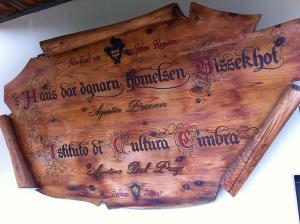
There are lots of place names of Cimbrian origin in which you run into, reading the books of Mario Rigoni Stern or wandering through the Plateau. However, there is someone who argues (Paola Barbierato, “L’Altopiano dei Sette Comuni”, edited by Patrizio Rigoni and Mauro Varotto, Ed. Cierre, 2009) that those names are a germanisation of names previous to the German waves of immigration, and often related to the names of rural properties. The micro-toponyms are purely Cimbrian instead, derived from the further use of the land. Here are some examples, with the Cimbrian meaning and the other one linked to the Latin origin of the names (in texts and maps the writing is not always homogeneous).
Asiago: from “Sleghe,” cutting of forests (or the Latin antecedent for “forest of Asillius”)
Roncalto: as Ronchi, it would derive from the medieval Latin “runcum,” tilled ground
Stoccareddo: from “Stock,” stump
Conco: from “Kunken,” basin, district (or from the Latin word “concha,” depression)
Lusiana: from “Lusaan,” plants, pastures (or from the Latin words “Lucilius’ farm”)
Enego: from “Ghenebe,” fortress near the water (or derived from the personal name Enika or Enicus)
Foza: from “Wüsche,” lawn (or “Fovea,” then “fodia,” hole)
Gallio: from “Ghel,” place of water (Ghelpack and Frenzela born here, but also from “Galatus,” greek name of the Gauls)
Roana: from “Robaan,” solid housing (or from the Latin “Rubus,” bramble)
Camporovere: from “Kamp-roban,” clearing in Roana (or “Campus robur,” field of the oak)
Canove: the oldest of the cimbrian names, “Roan,” long bump; it was the Romance name which was then set in the 16th century, “new houses”
Cesuna: from “Kan Zune,” fenced houses (or from “caedere,” to deforest)
Treschè: from “Skada,” stumps (or from “tresca,” haystack)
Rotzo: from “Rotz,” grassy slope (or from the Latin “rozium,” flock)
Altaburg: old village or old castle
Altarknotto: old stone
Val d’Assa: from “Ass-tal,” water flowing in a deep valley
Barental: valley of the bears. Tal, valley, is found in many compound nouns
Bisele: small meadow (the diminutive suffix “-le” identifies with good accuracy the Cimbrian toponyms)
Croxebech: Cross Square
Ecke: bump, hill, with many variations often in the diminutive form
Ebene: plain
Ferrozzo: the other name of Cima XII, from Freyjoch, mountain dedicated to the goddess Freya
Frenzela: from Freyentaal, valley dedicated to the Goddess Freya (or river in a deep valley)
Kaberlaba: mountain of the pond (“Laba”)
Katz: perhaps from Cimbrian “Khatz,” broad-leaved tree, or “steep path, for cats.” The variant “Monte Bi” refers to the shape of the two paths that cross it to the top
Gadena: precipice, ravine
Gaiga: village on a hill
Grabe: grave, widespread in many variations, related to valleys and streams
Ghelpack: Gallio’s stream
Laite: slope, with Laiten and Leite variants
Marcesina: from “Merck-wisen,” border meadows
Martello: from “Mar-tal,” valley dedicated to the goddess Mara, or “big valley”
Mazze: da “Maez,” country
Moor: stony and friable mountain
Mos: with the “Mosc,” “Mosciagh,” “Mosele” variants, it refers to a swamp
Portule: from “Por,” mount, and “tell” or “tull,” steep
Prunde: with the “Prundele,” “Prunele,” “Prunno” variants, indicates a source
Zebio: as “Zovo,” “Zovetto,” “Zoviello” derives from the word for pass, yoke
Prunde: con le varianti Prundele, Prunele, Prunno indica una sorgente
Zebio: come Zovo, Zovetto, Zoviello deriva da passo, giogo


